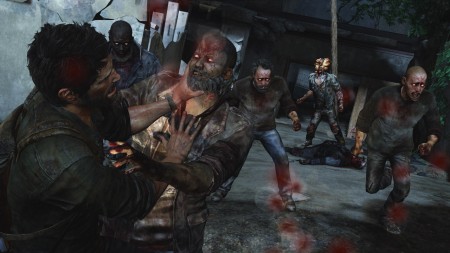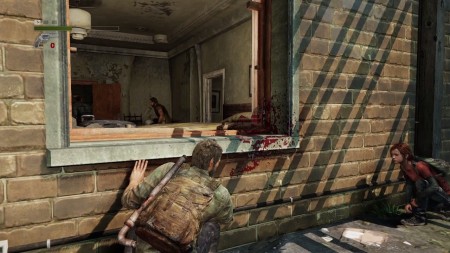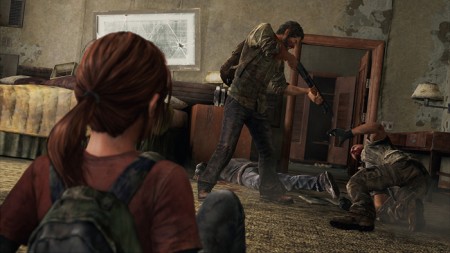Goodbye bandicoots, hello zombies.
It’s bizarre to think the same developer responsible for the cartoony marsupial hijinks of Crash Bandicoot could also be responsible for their latest title, The Last of Us. Crash Bandicoot was colourful and fairly innocent – in the first three titles, at least. I still haven’t forgotten that ‘are those real?’ line in Crash: Twinsanity. I suppose, looking back at each of their franchises, you can see a natural progression towards what they’re bringing to the table in 2013. Crash Bandicoot’s goofy platforming carried over into Jak & Daxter, which eventually became a lot darker and serious in tone, as well as throwing weapons and vehicles into the mix. Then we had Uncharted – a more cinematic, violent experience that still held the tongue-in-cheek humour. Now the Indiana Jones-esque fun is gone and replaced with terror and grit. It’s a massive departure from their roots – so how well does it work?
The Last of Us, for the most part, is the story of two survivors – Joel and Ellie – in a world ravaged by a freakish mutation of the Cordyceps fungus. Regular people are turned into bloodthirsty creatures, growing hideous fungal growths and a desire to turn you into lunchmeat. What we’re talking about here is more or less a zombie, but less George A. Romero and more Plants vs. Zombies. Don’t take that as mockery or me saying they’re not scary – they’re bloody horrifying. You’ll find yourself trapped in the dark far more than once, sneaking around hallways or courtyards as you hear one of them clicking its tongue, using the sound to seek you out and finally tear a meaty bite out of your throat.
They’re not the only thing for Joel and Ellie to fear, though. Bound by their losses and hopes, the two are travelling across the United States to find the headquarters of the Fireflies, a resistance group who are trying their best to find a cure for the horrid virus; and Ellie might just be what they need. Along their way, they’ll come across all kinds of baddies, infected and otherwise. It’s a cruel, starved and overgrown world full of hateful and scared people willing to do anything to survive. Joel and Ellie meet all kinds of friends and foes on their journey; but despite initial skepticism of each other, their desires and choices are what holds them together and makes the story truly enjoyable.
Post-apocalyptic stories are all the rage right now – especially those starring the undead or general flesh-eating creeps. In a sea of zombie and zombie-related media, it’s the characters and the ways the creators deal with their situation that make any of it stand out from the crowd. It’s not just a physical journey that Joel and Ellie undertake, it’s the story of a relationship formed by extreme circumstance and experience, and it’s enjoyable to see how their roles and attitudes towards each other change as we progress.
While the story and characters are what gives the game its strongest suits, there are some very enjoyable mechanics, which strengthen the stakes further. Rather than being supplied with unlimited ammo and regenerating health, you’re forced to make do with whatever you find out in the open or on fallen enemies. How scarce resources are differs wildly depending on what difficulty you’re playing on – and unlike many modern AAA games of its ilk, The Last of Us is a very stressful challenge on the higher difficulties. If you want to survive, you’ll need to prioritize being stealthy. Running out into the open and trying to play like a regular third person shooter will get you killed faster than you can say ‘Clicker’ – and by the time you’ve finished the campaign, you’ll be glad to never hear that name again.
Joel is perfectly capable of silently snuffing out enemies, but you’ll need to be very careful. Bandits will spot the bodies of their buddies you’ve taken out and will spread out to find you. There’s another stealth mechanic that you’ll find very handy if you’re so inclined, allowing you to listen closely to the footsteps and noises produced by enemies, visualizing them through walls and around corners. It’s somewhat similar to the abilities Agent 47 had in Hitman Absolution, which are honestly just as strange here as they were there. This may be immersion breaking for some, and I personally felt a bit cheap using it and tried to avoid it as much as possible. It’s incredibly rewarding to silently take out every enemy in an area, and even moreso to get by without even putting up a fight at all.
In many cases this is going to be your best bet – unless you want to fight barehanded, you’ll need makeshift weapons like shivs, Molotov cocktails and more. These require resources, and as previously mentioned, these aren’t exactly easy to come by. There’s a crafting system, which is simple in presentation and allows you to put items together on-the-fly fairly easily. You’ll have to craft sparingly, of course, because you’ll run out fast. This makes enemy encounters tense and requires planning – especially when you run into certain enemies whom can only be killed with certain weapons. Prioritize or die!
The action itself isn’t revolutionary, controlling and feeling much like Uncharted. The controls and mechanics are familiar and solid for those who played Naughty Dog’s previous releases, and straight-forward enough for newcomers to pick up on them pretty quickly. You’ll do plenty of climbing, crouching and running, and movement flows smoothly. No clunky or awkward animations in sight.
Most of the game jumps between exploring the environment, surviving combat and making your way through abandoned landscapes, and for the most part, it’s fairly linear. This is mostly down to the nature of the storytelling – there’s plenty of plot, spanning upwards of a year across multiple states and many characters to meet in between. Readers looking for a more open-world experience will be disappointed, as this is no Dead Rising. The story definitely takes the stage more than the gameplay, and while the gameplay is certainly solid and tense, this is definitely a strong example of modern cinematic gaming. Take that as you will.
As the new generation of consoles is born, it’s nice to see developers squeezing the last performance out of a console nearly a decade old. Despite running on what’s pretty ancient hardware in 2013, The Last of Us is a very pretty game. There’s some gorgeous lighting, and the detail on characters and the environment is boggling considering how little memory Naughty Dog had available to them. There’s no denying it would look absolutely astounding at 1080p with more anti-aliasing and higher resolution textures on a PlayStation 4 – but as PlayStation 3 games go, this is top-notch. A cinematic game needs to look the part, too, and The Last of Us certainly delivers with the hardware it’s on.
There’s even a fantastic score by Gustavo Santaolalla, who was previously responsible for composing the scores for Brokeback Mountain and Babel. It’s not what you’d normally expect from a horror game – there’s plenty of acoustic guitar, and it’s not always as somber as it is uplifting. The main theme is juxtaposed with the dark, disturbing themes the game’s story deals with and makes for a very interesting tone.
Once you’re done with the singleplayer story, there’s a multiplayer mode called Factions to dig into which puts you in charge of a group of survivors who rely on you to win matches in order to keep them fueled with supplies. Picking from the Hunter or Firefly factions, you have twelve weeks to maintain your group of survivors, with each match representing a day. Killing enemies and crafting items are amongst the things you can do to scavenge supplies – and losing matches will take them away, too, threatening the lives of your group. It’s nothing outstanding – a fairly standard Deathmatch mode and another with no respawns – but the supply carry-over aspect makes it interesting enough to give it a try.
Final Thoughts:
Overall, The Last of Us is a very interesting achievement for Naughty Dog. It’s not a perfect game – it really could have done without the repeated and tedious plank and ladder platforming sections, a multiplayer mode that doesn’t inspire repeated plays and the friendly NPC AI not being detected by enemies does seem somewhat bizarre and immersion-breaking. What it comes down to, though, is that Joel and Ellie are convincing and likeable characters backed by great performances by Troy Baker and Ashley Johnson, and the scarcity of resources allow you to share their fear and tension. It’s a frightening, violent experience. There’s heavy debate over whether this would have worked better as a movie due to its heavy emphasis on linearity and storytelling – while this is certainly up for discussion, as a game it’s still a very solid experience, and hopefully the sign of more quality serious work from Naughty Dog in future. After more Crash Bandicoot, of course.
 BrutalGamer Bringing you Brutally Honest feedback from today's entertainment industry.
BrutalGamer Bringing you Brutally Honest feedback from today's entertainment industry.








